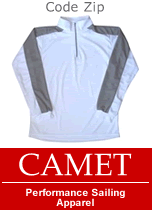
Photo credit: Alinghi Post sponsored by J World San Diego
Port America’s Cup passers-by have been doing a double take recently due to the new arrival of two small weather planes at the Alinghi camp. Jon Bilger, Alinghi’s chief weather man, has the answers …
Can you describe these devices? Are they planes, gliders?
They are a combination of both. They are basically a plane with floats on them, so they can take off from the water and fly, but the idea is that we can measure the wind speed at any height we like. With a boat we're stuck at six metres but the planes can go to the height of the mast which is the equivalent of a 17-storey building.
What are these planes used for?
We're using them like a weather boat to measure wind speed and direction. They can fly relatively slow: from 25 knots up to 60 and we can cover a large area. The last America’s Cup was a race area of nine square miles and we have now an area of 450 square miles to cover, so we need some different equipment to do that effectively.
When will these planes be used and who will fly them?
We have two planes and we'll use them pretty much every day that the conditions are good for sailing Alinghi 5. The company we use is from Australia and we have a couple of experienced pilots to fly them.
Is this a landmark in the history of the AC weather collection?
Back in San Diego, they used helicopters for wind observation, so you had some sailors up in those helicopters to look at wind on the water, but this is quite a different application because we're actually measuring the wind speed and direction. It's quite hard to measure the wind speed and direction on a helicopter because of all the down draft, but on these we can do it very accurately.
How will the collected data help the team and the boat?
Because these boats are going so fast and because they are so large, the sailors won't be going up the mast unless absolutely necessary, not to spot wind. On an old America’s Cup course you could see quite a long way when you were at the top of the mast, so the decision making from the sailors was quite important but this time, because they are going so fast, and they tack relatively slow compared to how fast they go, deciding which side of the course is going to be done before the start of the race on the information we give them so it will be quite critical for them to go the right way. If the two teams go different ways they are going to be a long way apart in a short space of time.
How will the weather data collection work in the next AC?
Last time we were very fortunate to have the MDS (Meteorological Data System), which is a great programme. We had 23 weather buoys and a lot of land based stations, so a lot of the data we received was supplied that way. This time we have to do it ourselves... http://www.alinghi.com/







